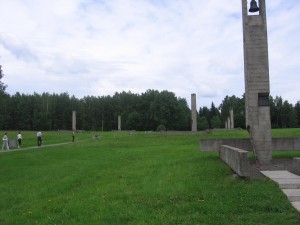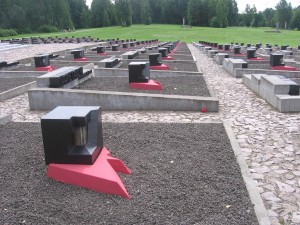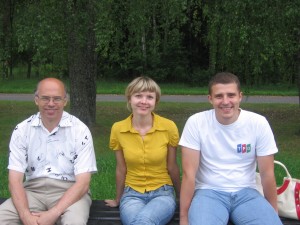The next day we went to the National Memorial Complex at Khatyn.?? This memorial is the sites of the formed village of Khatyn, razed to the ground in the spring 1943, and its inhabitants burned to death.?? It is not to be confused with Katyn, the forest at which the bodies of 22,000 Polish offices and civilians, taken in the Soviet invasion of Poland in 1939, were shot and buried by the Soviet secret police, the NKVD.?? The kh in Khatyn is pronounced as h in English, as my pronunciation was kindly corrected.? The confusion is understandable, and has been the source of much discussion.
The website for Khatyn is excellent, and in English, so I will not recount the story here.
http://khatyn.by/en/
Yet, here are a few facts.?? In response to a partisan attack in which a well-known German officer was killed, the Germans encircled the village of Khatyn on March 22, 1943.? The inhabitants of the village were rounded up and herded in the barn.?? The barn was burned to the ground with the villagers in it. Those who tried to run for safety were shot. The log homes in the village were then burned, leaving only the chimney to mark the sites.? 149 people including 75 children died.?? Amazingly, six people survived, including the blacksmith, Joseph Kaminsky.? After the Germans were gone, he looked for his son, who was still alive, but who then died in his arms.
Khatyn has become a symbol of all the 618 Belarusian burned villages and their inhabitants, and the 185 villages that were never rebuilt.?? It is also a monument to all civilian deaths in all wars.? Perhaps some of my reference students could help me here, but it is my sense that civilian deaths were relatively low in WWI and have increased dramatically as a percentage of total casualties in WWII and subsequent wars.?? As we achieve greater sophistication in our societal organization, build better weaponry, and have a better understanding of human rights, it seems we are also much more willing to take the lives of civilians to advance the cause.?? What I took from Khatyn is that Khatyn is in all of us, and despite its warning, it will happen again.
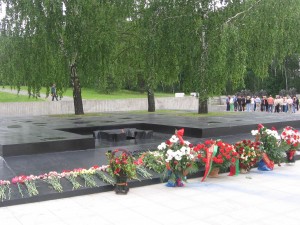
One in four died in Belarus in the Great Patriotic War. The three trees symbolize the living. The flame represents the missing.
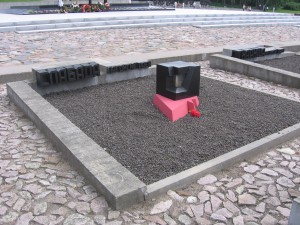
A representation of a missing village, with some dirt or other material from the village in the central container, sitting on red fire.
